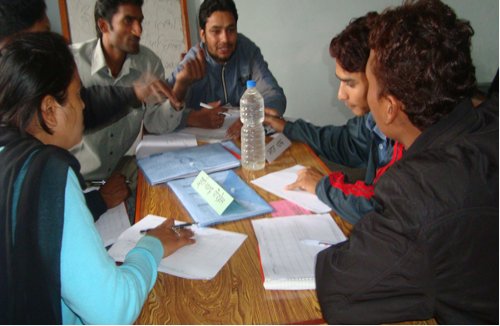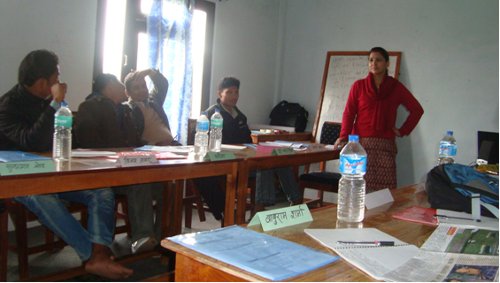I did not feel safe when I travelled to Bardiya in the last week of November, 2010. Just before my journey, the district treasurer of the Nepali Congress was killed by unidentified persons on the east-west highway near the Bardiya National Park, while he was returning to his home around 6pm. I landed at nearby Nepalganj airport around 6.30pm, and then had to drive one-and-a-half hours to the district headquarters of Bardiya, at Guleriya. Just a couple of days before, two children aged 13-14 had been kidnapped for ransom near Nepalganj, and killed after the kidnappers received the ransom money. My unsafe feeling increased when I drove through the village where the kidnappers lived, as my driver suddenly told me this. Thank God! I arrived safely at the hotel where my accommodation was booked for the next four days.
Bardiya is the district of Nepal where the highest number of people disappeared during the decade-long internal armed conflict. Altogether 220 disappeared and 322 lost their lives during the conflict. The population of Baridya is 382,649, with Tharu, one of the indigenous communities, composing 99,614. Bardiya is one of the Tharu-dominated districts, along with Dang, Banke, Kailali and Kanchanpur in the western part of Nepal. Therefore these districts (along with some other parts of the country) have been claimed for a Tharuhat state/province in the new federal structure of Nepal by the Tharu communities. At the same time, most of the Madhes-based political parties have been demanding ‘one Madhes one Pradesh’ (one Madhes, one state/province), in all the lowlands of Nepal from the east to west. Tharu people have been claiming that they can not be accommodated in the Madhesi, they are Tharu, an indigenous community of Nepal, and they have been demanding a separate Tharuhat Province.

However, the people of Bardiya district have not yet healed grievances from the decade-long internal armed conflict. They fear possible unrest in the district, on account of demarcation of the future federal state. What I learnt, during my conversion with the local people and civil society members, is that they did not have any energy left to fight again, to bear the effects of conflict or to support to conflict any more. Local people and even district-level political workers did not show any enthusiasm for future conflict. They all have already suffered unbearable impacts of conflict - some lost a husband, some lost a wife, some lost a son or daughter, and even some do not yet know the whereabouts of their beloved.
I easily observed their frustration with the top political leaders of the all major political parties that they have not been delivering the promises they made to the Nepalese people. Slapping by one local cadre of Mr Jhalanath Khanal, president of the Communist Party of Nepal-Unified Marxist and Leninist (CPN-UML), at a public event in Itahari, Sunshari, on 19 January, is a perfect example of the people's frustration with the senior political leaders.
Civil society workers and local- and district-level political leaders are not staying silent or just blaming and throwing frustration at the senior political leaders: they are engaging to address the impacts of the internal armed conflict and working to prevent future unrest in the district. What I found interesting was that they meet at least once a month and discuss and talk about the actual needs of the conflict victims, in the presence of those victims. They also hand over a written statement about the victims' needs to the relevant government authority.
Civil society activists and political workers further interact with each other about the current political situation, about the impact of central political activities in the district, and about what action should be taken to prevent the situation deteriorating. I had a chance to facilitate the interaction programme, and we particularly discussed victim justice and reparation during the transitional phase.

Their monthly meeting sometimes becomes tense, when people are divided on the issue of victims from different conflict parties - either from the government or from the Communist Party of Nepal-Maoist (CPN-M). We have two different forums developed by the conflict victims - one is developed by victims of the CPN-M’s actions, and another is developed by victims of the government's actions - mainly by the Nepal army, Nepal policy and the armed policy force.
The latter forum is formed by the Maoist party itself. It is unfortunate that the conflict victims are divided, particularly on ideology, even though their pain and grievances are same.
The division within conflict victims also affected the Conflict Victims Committee (CVC) working in Bardiya. Former chairperson and general secretary of CVC, Bhagiram Chaudhary and Niranjan Chaudhary respectively, were ousted from their post from CVC. Initially CVC had included all the conflict victims, regardless of victims from which conflict party. CVC has also become a victim of ideology, and Bhagiram Chaudhary and Niranjan Chaudhary were forced to quit from their posts.
However, the National Network of Disappearance Family of Nepal has been formed with initiation from Bhgiram and some other conflict victims, regardless of any ideological thoughts, and Bhagiram is secretary. What I found during my conversation with him is that his enthusiasm has not been decreased - he is even more committed to establishing peace in the country.
Of course, there are some differences and weaknesses for consolidating actions for peace in the district. People - basically civil society activists and the district/local-level political workers - have been actively engaging for addressing needs of the conflict victims and orientating people about non-violent conflict resolution methods such as dialogue, mediation and negotiation. They have been further working for preventing future unrest and future violence in the district, particularly on the issue of federalism. In addition to these activities, they have been orienting people about a non-violent movement. They don't ignore the necessity of the movement to ensure rights of the marginalised and backward communities, therefore they have been orienting people about non-violent action.
The interaction program that I had a chance to facilitate has prepared a joint action plan for a year, between civil society activists and the district/local-level political workers. Sharing the topics we discussed in the interaction with their respected institutions, mediating conflicts in the district, holding protest programmes in non-violent ways, and supporting conflict victims for reparation, are some of their planned activities.
I could easily read on their faces their eagerness to work for peace, during the drafting of the action plan. Joint action between political workers and civil society activists is really an effective initiation for establishing peace, since division within civil society activists has been seen on ideology, and mostly youth fronts of the political parties have been in disagreement even on minor issues.
I also promised in front of them that I would share this effort with other forums, so that it can be replicated for the cause of peace.







